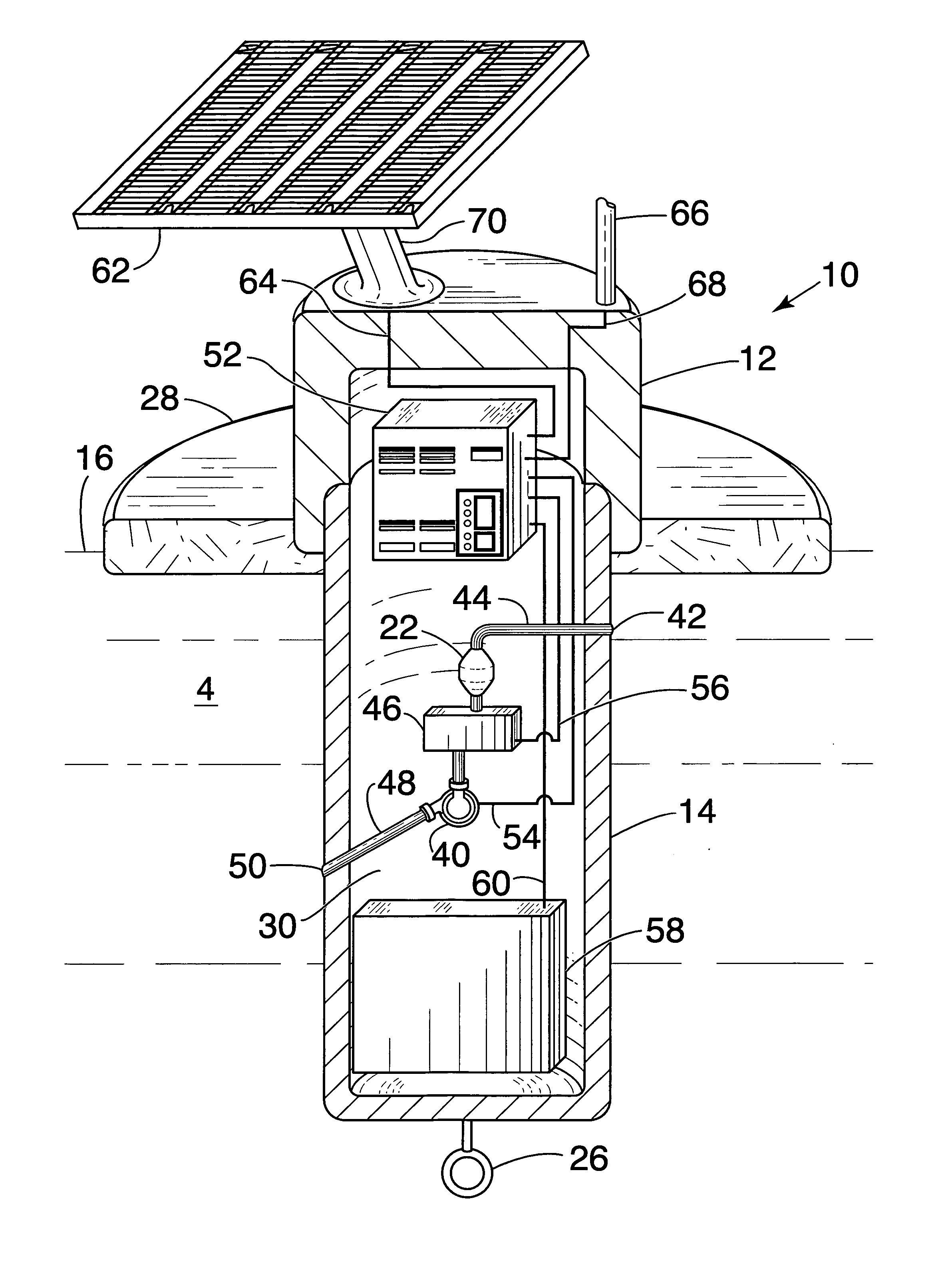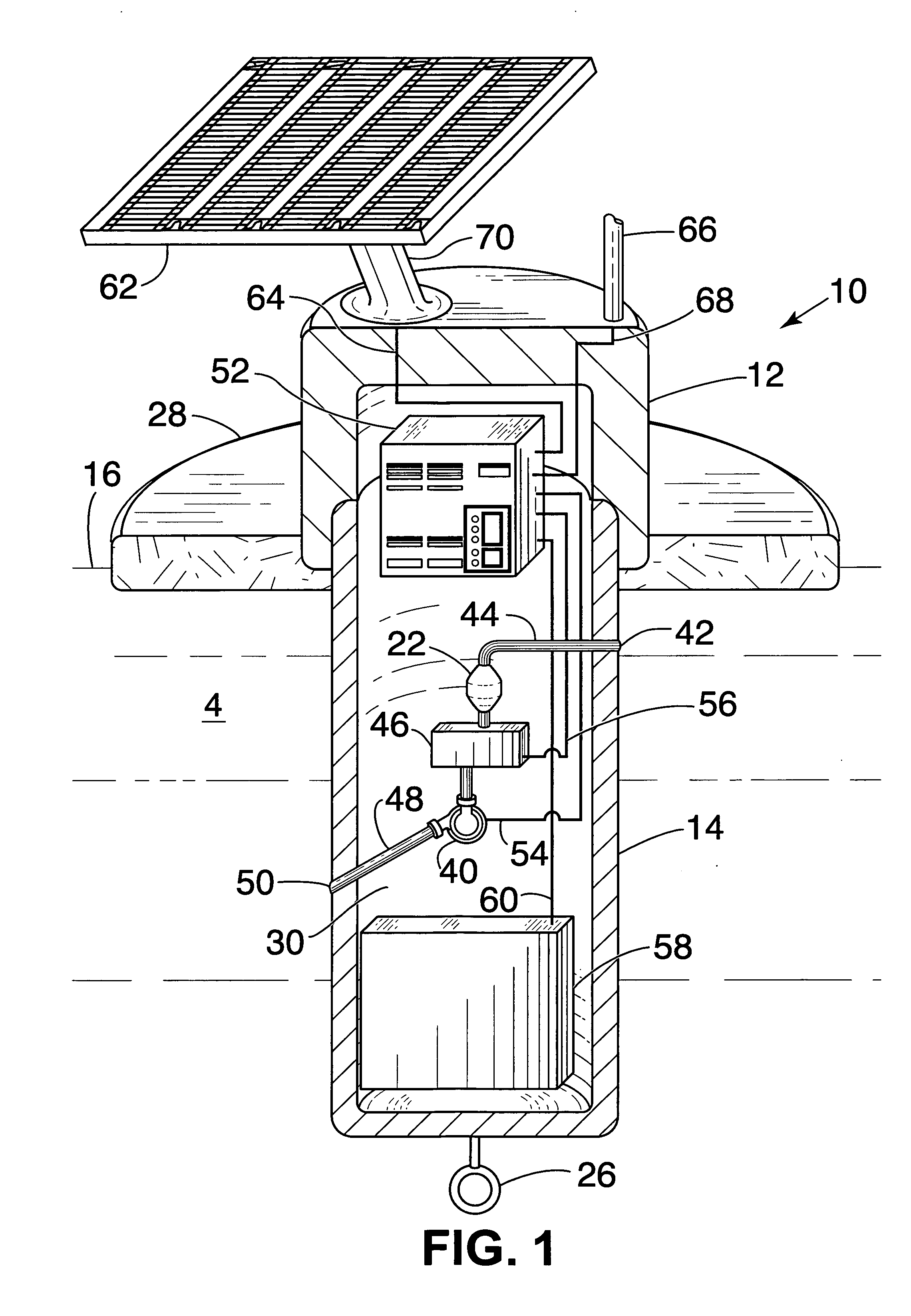Enhanced monitor system for water protection
a monitoring system and water protection technology, applied in pollution detectors, instruments, chemical indicators, etc., can solve problems such as the vulnerability of civilian populations and military installations to such attacks, and achieve the effect of preventing freezing and/or overheating
- Summary
- Abstract
- Description
- Claims
- Application Information
AI Technical Summary
Benefits of technology
Problems solved by technology
Method used
Image
Examples
example i
[0038] The water-soluble salt potassium cyanide (KCN) was used to test the invention. The effect of 2 mM KCN was tested on the fluorescence emission of “as is” water samples containing naturally-occurring algae from the Clinch River. The Clinch River is the main source of drinking water for Oak Ridge, Tenn. After an initial control (no KCN) fluorescence measurement, KCN was added directly into the water sample. FIG. 3 shows the change in the fluorescence induction curve after 2, 10 and 15 min exposure of the algae to KCN compared to the control.
[0039] Methyl Parathion (MPt) is an organophosphorus insecticide used to control soil-dwelling pests and a wide range of insects and mites that infest agricultural crops. It is a cholinesterase inhibitor that is structurally and functionally similar to the chemical warfare agents classified as nerve agents (including VX and GA). Severe exposure in humans and animals can lead to convulsions, unconsciousness, cardiac arrest, and death (Guideli...
example ii
[0040] The effect of 20 μM MPt was tested on the fluorescence emission of “as is” water samples containing naturally-occurring algae from the Clinch River in Oak Ridge, Tenn. After an initial control (no MPt) fluorescence measurement, MPt was added directly into the water sample. FIG. 4 shows the change in the fluorescence induction curve after 2, 10 and 15 min exposure of the algae to MPt compared to the control.
[0041] N′-(3,4-dichlorophenyl)-N,N-dimethylurea, also known as DCMU and Diuron, is a substituted urea-based herbicide employed principally for control of vegetation in non-crop areas, including irrigation and drainage ditches. Diuron is a nonionic compound with moderate water solubility. The U.S. Environmental Protection Agency has ranked Diuron fairly high (i.e., as a Priority B Chemical) with respect to potential for groundwater contamination. Diuron is of low acute toxicity (Guidelines for Canadian Drinking Water Quality, 1996). The present invention can detect methyl p...
example iii
[0042] The effect of 10 μM DCMU was tested on the fluorescence emission of “as is” water samples containing naturally-occurring algae from the Clinch River in Oak Ridge, Tenn. After an initial control (no DCMU) fluorescence measurement, DCMU was added directly into the water sample. FIG. 5 shows the change in the fluorescence induction curve after 2, 10 and 15 min exposure of the algae to DCMU compared to the control.
[0043] A summary of the decrease in photochemical yields measured at 0° C. with “as is” water samples containing naturally-occurring algae from the Clinch River in Oak Ridge, Tenn. is illustrated in Table 1. These results show the present invention to be effective in detecting the presence of these toxic agents in primary-source drinking water at such a low temperature.
TABLE IPercentage (%) decrease in photochemical yield at 0° C. fornaturally-occurring algae from water samples of the Clinch River,Oak Ridge, Tennessee.Time after2 mM Potassium20 μM Methyl10 μMexposure...
PUM
| Property | Measurement | Unit |
|---|---|---|
| time | aaaaa | aaaaa |
| fluorescence | aaaaa | aaaaa |
| fluorescence induction curves | aaaaa | aaaaa |
Abstract
Description
Claims
Application Information
 Login to View More
Login to View More - R&D
- Intellectual Property
- Life Sciences
- Materials
- Tech Scout
- Unparalleled Data Quality
- Higher Quality Content
- 60% Fewer Hallucinations
Browse by: Latest US Patents, China's latest patents, Technical Efficacy Thesaurus, Application Domain, Technology Topic, Popular Technical Reports.
© 2025 PatSnap. All rights reserved.Legal|Privacy policy|Modern Slavery Act Transparency Statement|Sitemap|About US| Contact US: help@patsnap.com



